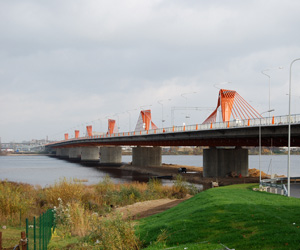Results of Load Testing the South Bridge
Final results of load testing the South Bridge have confirmed the provisional data – results of the test and analytical estimations show that the newly built South Bridge over the Daugava River in Riga can withstand daily traffic loads.
The daily traffic loads are determined by the CM Regulations No. 571 of 29 June 2004 Traffic Regulations in Appendix 3. The bridge can also withstand the normative loads anticipated by the LVS EN 1991-3 Traffic Loads for Bridges.
Testing of the loading results has been performed by the Transportation Engineering Institute of the Faculty of Building and Civil Engineering of the Riga Technical University.
It is stated in the conclusion that in the process of testing the bridge the established deflections and strain do not exceed the strength indices of the material applied in the constructions. The bridge dynamic testing shows that the bridge has the slightly increased level of dynamic characteristics, but these do not impact the bridge strength indicators. The level of dynamic characteristics does not exceed the one determined by the project.
Loading of the bridge took place on 23 October 2008. Static and dynamic testing has been performed. For the bridge static testing, 32 vehicles have been used. Mass of the vehicles was from 39.12 t – 40.18 t. The average mass is 40.016 t. The total mass of the vehicles was 1,280.51 t. The bridge testing with the load was performed in accordance with the eight previously determined schemes by estimating the vehicles placement combinations, when the maximal load is exerted.
When performing the dynamic testing, one vehicle was crossing the bridge at a speed of 40 km/h. The 4-5 cm thick laths were placed on the roadway and the drives were repeated at a speed of 40 and 60 km/h. To determine the natural vibration frequency, one vehicle was coming down fast from the 20 cm high springboard. Static deflections, fluctuation amplitudes and frequencies were measured during each drive.
It is to be noted that solutions of the bridge constructions anticipate that the initial deflections of two spans in the centre of the span is 10 cm and 13.4 cm. The largest deflection measured during the test was 201 mm on the 6th span – this could be observed also visually. The remaining deflections on the loaded spans are from 3 mm to 18 mm, or approximately 5% – 9.5% from the deflections caused by the test load – this fully conforms to the expected results and the anticipated standards.
Riga City Council
City Development Department
Public Relations Division


